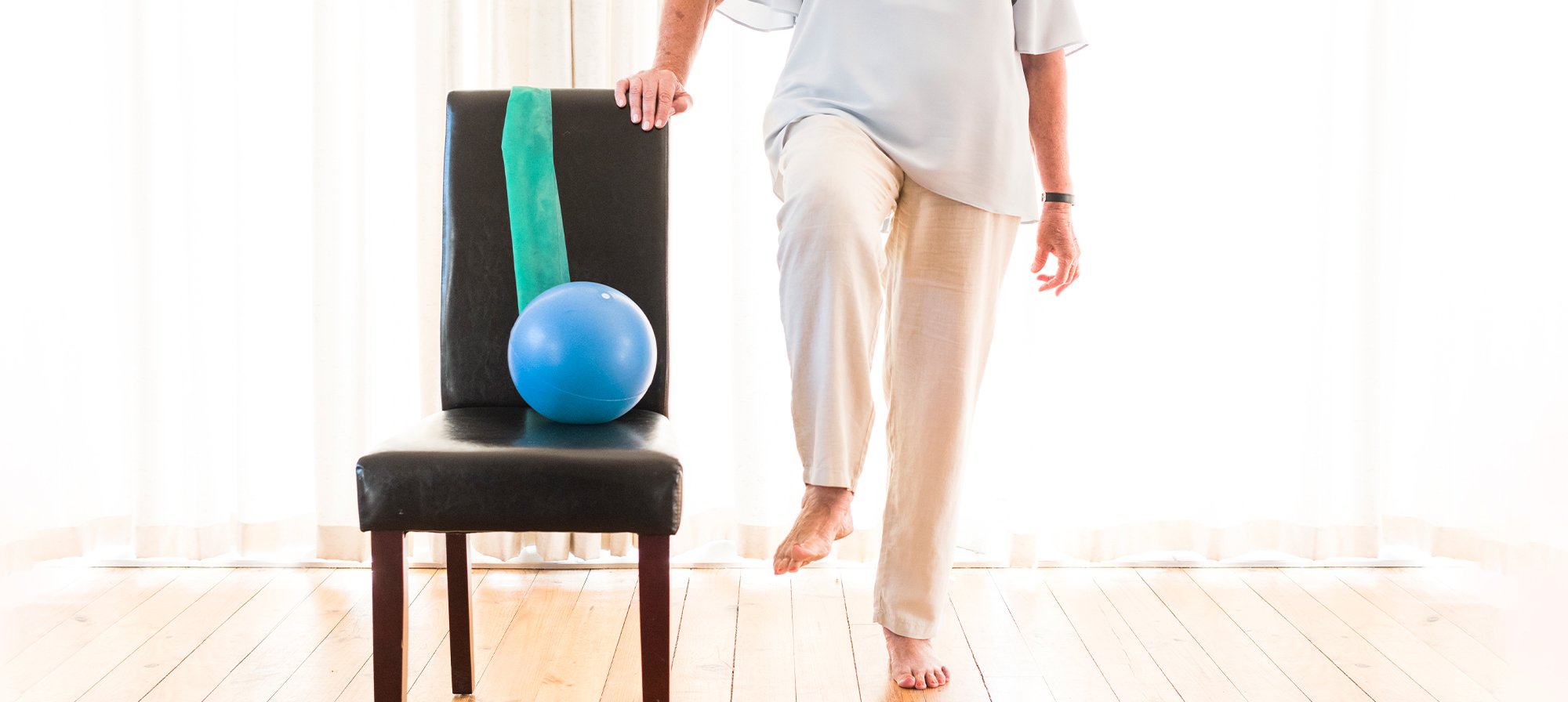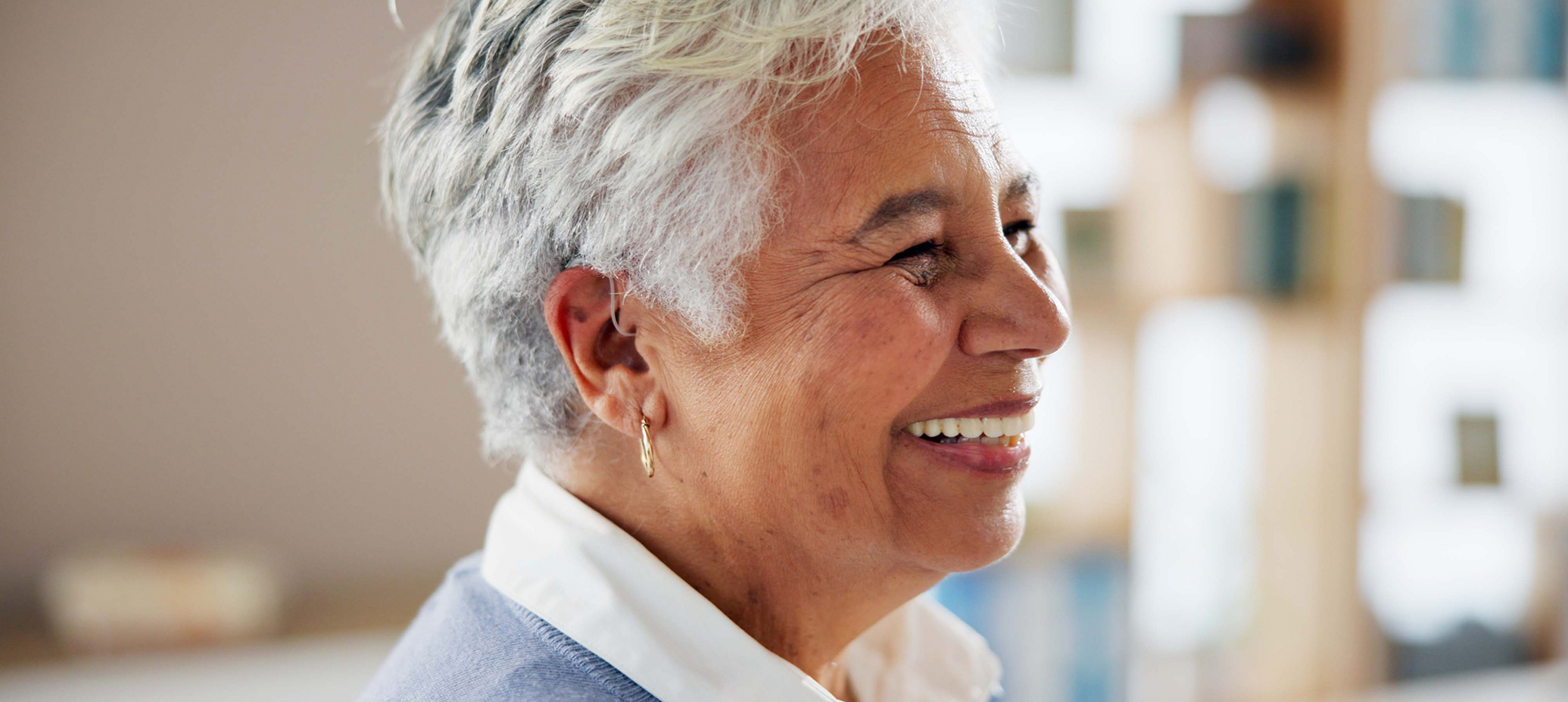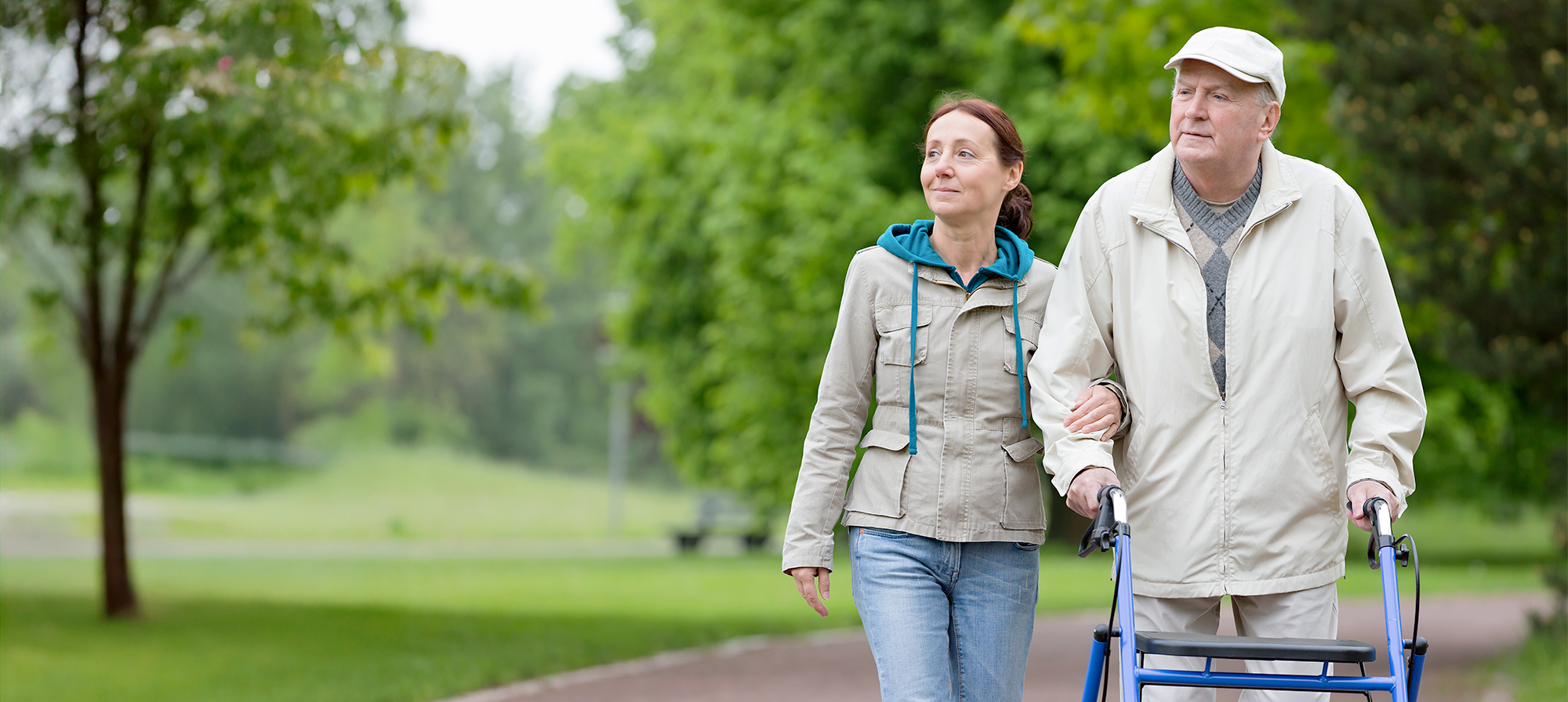Taking a fall, at any age, is scary. Falls can lead to injury—possibly serious or even life-altering ones.
That makes fall prevention a crucial part of staying safe, healthy, and independent as you age. One way to lower your risk of falls is to add balance, mobility, and strength training to your fitness routine.
No matter your age, current fitness levels, or health, you can safely weave this trifecta of trainings into your routine. Even if you have balance, mobility, or strength problems already, you can improve them. You will just want to talk with your doctor first if these 3 types of training are new to you. Let’s take a closer look at each one and the role they play in fall prevention.
1. Balance
A sense of balance is one of the first things you develop in life. Without balance, you could never learn to walk, ride a bicycle, or even sit or stand.
Good balance helps you maintain a stable and upright posture, whether you’re moving around, standing still, or sitting. This human ability to stay upright is maintained by a complex system of senses that lets you know where your body is in relation to your surroundings.
As you age, your balance may not be what it once was (for a range of reasons). Thankfully, you can take steps to address these underlying reasons and keep your balance intact.

What can cause balance problems?
Understanding what causes a loss of balance is the first step in helping to restore it. Some of the common causes are:
Loss of strength and muscle mass. Strength in the muscles of your core (trunk) is key to good balance. Many older adults tend to have weak core muscles. They also may have less muscle mass and strength overall. This is often the result of inactivity. A loss of strength in the hips and legs can also cause balance problems.
Foot, ankle, knee, and hip pain. Pain from arthritis, soft tissue injuries, or a loss of strength and flexibility in your lower extremities, can impact your walking and therefore your balance. This in turn can raise your risk for falls. Problems with the feet due to diabetes can also weaken your balance. So can ill-fitting footwear.
Diminished reaction abilities. Older adults may not be able to react or move as quickly as they once did. You may lose some of the ability to catch and regain your balance if you trip and start to lose your center of gravity.
Medical conditions. Parkinson’s disease, stroke, and rapid drops in blood pressure after standing up (orthostatic hypotension) are a few of the many health problems that can weaken balance. A loss of vision and/or hearing, or problems in the middle ear can also impact balance.
Certain medications. Drugs used to treat pain, sleep problems, heart disease, high blood pressure, or depression are just a few that can cause balance problems. Some meds may impair your balance by causing blurred vision, lightheadedness, drowsiness, or inner ear problems. Talk with your doctor about any meds you’re taking that may have these side effects.

Can you restore your ability to balance once it’s lost?
If your ability to balance has declined, there is a lot you can do to regain and strengthen it. Doing so will help lower your risk for falls.
If you think you’re starting to have problems with your balance, talk to your doctor before starting any kind of balance training. Your doctor may want to first rule out whether medications or health conditions could be causing your balance problems. They may want to refer you to a licensed physical therapist (PT) to assess your balance and tailor a training program that’s right for you.
On the other hand, if your doctor gives you the go-ahead to do balance training exercises on your own, you might want to work with a certified personal trainer if this type of training is new to you. You can also try an online fitness class that focuses on balance.
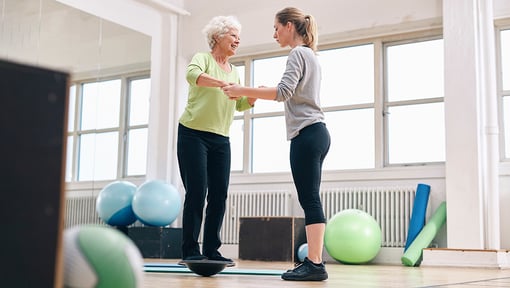
2. Mobility
Mobility is the ability to move freely and maintain your balance, no matter the activity you’re doing. Good mobility helps with just about every activity, such as:
- Walking
- Climbing up or down stairs
- Sitting down and standing up
- Getting in and out of bed, a bathtub, or a shower
- Getting to the bathroom in time
- Reaching for an item on a shelf above you
- Bending at the knees to grab something from a lower cupboard
- Bending over to pick something up
- Getting dressed
- Shifting your weight from one foot to the other during household chores
- Driving and running errands
- Exercising
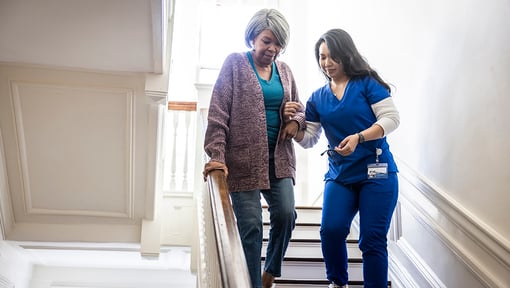
Why is good mobility so critical to preventing falls?
If your mobility starts to decline, your risk for falls goes up—for a host of different reasons.
Gait. Poor mobility can impact your gait. Your gait is essentially how you walk. It’s the smooth coordination of your muscles and body parts as you take forward strides.
Gait problems caused by poor mobility can make it easier for you to trip and fall while walking. Some of these gait problems include:
- Slower walking speed
- Decreased walking endurance
- Lower step height (how high you can lift each foot off the ground while walking)
- Shuffle step
- Decreased arm swing
- Decreased stability during direction changes
- A lack of symmetry in how one side of the body moves compared to the other
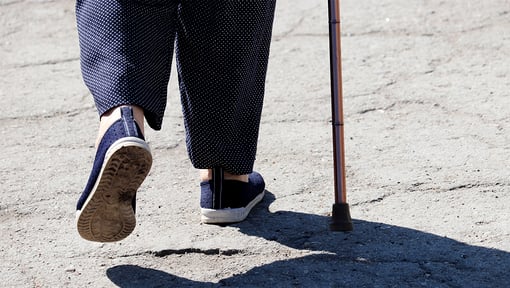
What can cause a loss of mobility?
A review of several studies found that some of the most common causes for a loss of mobility are:
- Age
- Lack of physical activity
- Obesity
- Loss of strength
- Loss of balance
- Health problems such as arthritis, diabetes, or stroke
- Smoking
- Depression and/or feelings of helplessness
- A recent hospital stay
Can you restore mobility once it’s lost?
Yes, you can make changes to your lifestyle and adopt mobility improvement exercises to help maintain and even strengthen your mobility. Talk with your doctor first to see if they think it best for you to work with a physical therapist. If you get the OK to do mobility exercises on your own, do your research and/or work with a personal trainer. Or you can stream mobility exercise classes online from home.
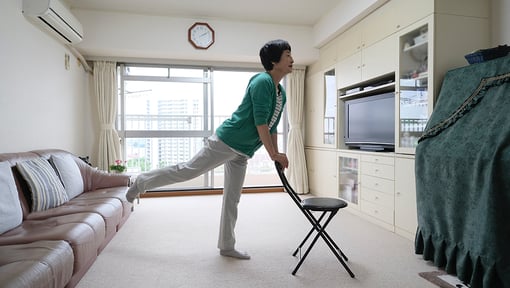
3. Strength
Strength is a measure of how much power, or force, your muscles can exert when you use them. It’s also a measure of how much weight you can lift and carry (including your own body weight). A strong lower body can help lower your risk for falls.
Why is strength important to fall prevention?
Strong legs. Having strong legs helps you carry your own body weight and move around safely and easily, with less chance of losing your balance and falling. For example, strong legs help you get in and out of bed. They help you sit down and stand up. They help you walk up a set of stairs. And they help you keep your feet under you while you do these and other activities.
A strong core. Your core (trunk) is made up of your abdominal muscles (located on the front and sides of your torso), along with your back, pelvic floor, and hip flexor muscles. A strong core helps stabilize your posture and your whole body when you move, whether you’re leaning over to grab a bag of groceries out of the car, walking, or doing household chores.
Muscle endurance. A lack of endurance means your muscles tend to tire more quickly when walking or doing other activities. Tired muscles can in turn impair your motor coordination and balance, thereby raising the risk for falls.
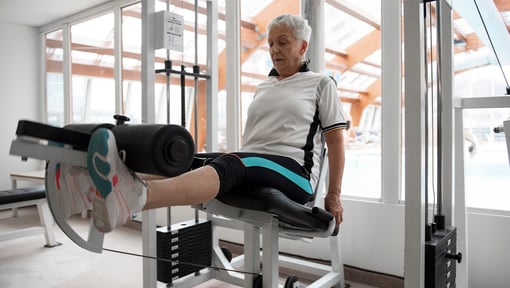
What causes a decline in strength and endurance?
Physical inactivity (too much sitting) is a common reason some adults, no matter their age, may lose strength and endurance. A lack of strength training may also be to blame.
Another reason is due to age-related muscle loss—also called sarcopenia. At around age 30, your body gradually starts to lose muscle mass. Over time, your body may become weaker.
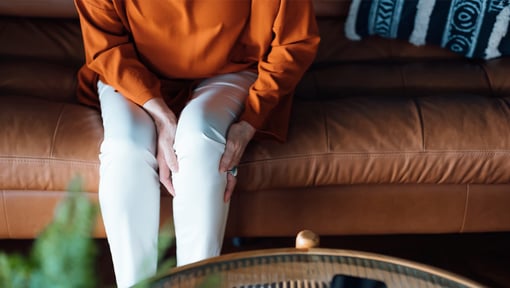
Can you restore strength and endurance once it’s lost?
Yes, through strength training and other forms of exercise, you can slow the loss of muscle mass, strength, and endurance. And it may also help you regain strength and endurance you’ve already lost.
If you’re already doing some sort of strength training, that’s great. Make sure to include strength training exercises for your core, hips, and legs 2 to 3 times a week. If this is new to you, talk with your doctor first to see if they recommend working with a physical therapist.
If your doctor gives you the OK to strength train on your own, you might work with a trainer or try group strength training classes at your gym or fitness center. Or look online for strength training classes that you can stream at home.

Other training options to lower your fall risk
The Otago Exercise Program (OEP). If your doctor suggests you work with a licensed physical therapist (PT), ask them about OEP. This is a research-backed program of 17 exercises for older adults at risk of falling. Some of the exercises are designed to help improve balance, mobility, or strength. Research suggests that the OEP may reduce falls in at-risk older adults by 35 to 40 percent.
The program is typically administered in-home by a PT. They will first assess your fall risk and then select which OEP exercises for you to do. But you can continue doing them on your own once you stop working with your PT.
Try tai chi. Tai chi consists of slow, graceful movements that often look like the movements of animals. These movements are really a series of individual poses that flow from one into another.
While the goal of tai chi is to break up blocks in the flow of chi, or vital energy, in the body, it’s also a great workout. It can strengthen your leg, hip, and core muscles and improve your balance, strength, flexibility, coordination, and mobility. The movements are low-impact and easy on your joints.
Walking. You might be surprised to learn that the simple act of walking more often can lower your risk of falls. It does this by helping to boost lower-body strength and overall endurance.
Walking, in part, may also help alleviate any problems you may have developed with your gait, which is essentially your coordination when you walk. If not corrected, gait problems can impair your balance and mobility.

Some final thoughts on fall prevention
Working on your balance, mobility, and strength isn’t meant to be a short-term solution. The hope is that keeping up with these 3 types of training to prevent falls will become a way of life for you—just as much as eating healthy and staying active are.
The more you can incorporate fall prevention practices into your daily life, the more you can reduce your risk of falling and the injuries they can cause. And that can help improve your odds of staying on your feet—and staying independent—for years to come.
Not a Silver&Fit® member? Learn more about everything the program has to offer, including more helpful healthy living tips like this, here on our website.
This information is not intended to take the place of regular medical care or advice. Please check with your doctor before using this information or beginning any self-care program. Images used for this article do not depict any members of the Silver&Fit Program.
References
American Speech-Language-Hearing Association. (2019, February 28). Hearing loss and the increased risk of falls. https://leader.pubs.asha.org/do/10.1044/hearing-loss-and-the-increased-risk-of-falls/full/
American Academy of Orthopedic Surgeons. (2012, October). Foot and ankle rehabilitation exercises. https://orthoinfo.aaos.org/en/recovery/foot-and-ankle-conditioning-program/
Bohrer, R. C. D., Pereira, G., Beck, J. K., Lodovico, A., & Rodacki, A. L. F. (2019). Multicomponent training program with high-speed movement execution of ankle muscles reduces risk of falls in older adults. Rejuvenation Research, 22(1), 43-50. doi:10.1089/rej.2018.2063
Centers for Disease Control and Prevention. (2017). What you can do to prevent falls. https://www.cdc.gov/steadi/pdf/STEADI-Brochure-WhatYouCanDo-508.pdf
Centers for Disease Control and Prevention. (2017). Medications linked to falls. https://www.cdc.gov/steadi/media/pdfs/STEADI-FactSheet-MedsLinkedtoFalls-508.pdf
Centers for Disease Control and Prevention. (2017). Stay independent: Learn more about fall prevention. https://www.cdc.gov/steadi/pdf/STEADI-Brochure-StayIndependent-508.pdf
Centers for Disease Control and Prevention (2021, July 26). STEADI (Stopping Elderly Accidents, Deaths & Injuries). https://www.cdc.gov/steadi/index.html
Cleveland Clinic. (2022, June 3). Sarcopenia. https://my.clevelandclinic.org/health/diseases/23167-sarcopenia
Dallek, L. (2010). Designing balance exercise programs for older adults. Retrieved from https://www.acefitness.org/certifiednewsarticle/687/designing-balance-exercise-programs-for-older/
Fragala, M. S., Cadore, E. L., Dorgo, S., Izquierdo, M., Kraemer, W. J., Peterson, M. D., & Ryan, E. D. (2019). Resistance training for older adults: Position statement from the National Strength and Conditioning Association. Journal of Strength and Conditioning Research: August 2019 - Volume 33 - Issue 8 - p 2019-2052 doi: 10.1519/JSC.0000000000003230
Guirguis-Blake, J. M., Michael, Y. L., Perdue, L. A., Coppola, E. L., Beil, T. L., Thompson, J. H. (2018, April). Interventions to prevent falls in community-dwelling older adults: A systematic review for the U.S. Preventive Services Task Force [Internet]. Rockville, MD: Agency for Healthcare Research and Quality. Available from http://www.ncbi.nlm.nih.gov/books/NBK525700/
Hauer, K., Lamb, S. E., Jorstad, E. C., Todd, C., Becker, C. (2006, January). Systematic review of definitions and methods of measuring falls in randomized controlled fall prevention trials. Age and Ageing. 35(1), 5-10.
Martin, M. (2017). 7 drills to enhance agility. Retrieved from https://www.acefitness.org/education-and-resources/professional/expert-articles/6391/7-drills-to-enhance-agility
Mayo Clinic. (2022, May 26). Orthostatic hypotension (postural hypotension). https://www.mayoclinic.org/diseases-conditions/orthostatic-hypotension/symptoms-causes/syc-20352548#:~:text=Overview,or%20lightheadedness%20and%20possibly%20fainting.
National Council on Aging (2021, July 13). 6 falls prevention steps to help your older loved ones. https://www.ncoa.org/article/6-falls-prevention-steps-to-help-your-older-loved-ones
National Council on Aging. (2021, October 13). Chronic conditions and fall risk: Cross-promoting programs across the continuum of care. https://www.ncoa.org/article/chronic-conditions-and-fall-risk-cross-promoting-programs-across-continuum-of-care
Robinson, L., Smith, M.A., & Segal, J. (2022, February). Senior exercise and fitness tips. https://www.helpguide.org/articles/healthy-living/exercise-and-fitness-as-you-age.htm/
Stutzman, Lora (n.d.). Fall prevention: Balance and strength exercises for older adults. https://www.hopkinsmedicine.org/health/wellness-and-prevention/fall-prevention-exercises
Schwenk, M., Jordan, E. D., Honarvararaghi, B., Mohler, J., Armstrong, D. G., & Najafi, B. (2013, November-December). Effectiveness of foot and ankle exercise programs on reducing the risk of falling in older adults: A systematic review and meta-analysis of randomized controlled trials. Journal of the American Podiatric Medical Association. 103(6), 534-547. doi:10.7547/1030534
This article was written by Gail Olson, edited by Jason Nielsen, and clinically reviewed by Elizabeth Thompson, MPH, RDN.
